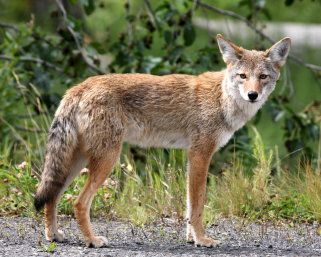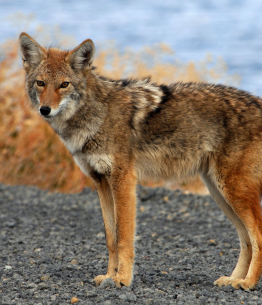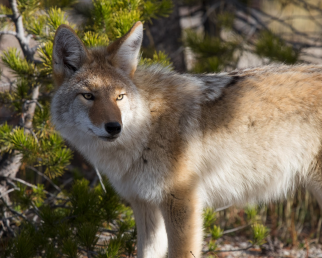Coyote Hazing Guidelines
How to Haze for Effective Reshaping of Coyote Behavior
 Generally, coyotes will avoid human contact. Coyotes who have adapted to urban and suburban environments, however, may realize there are few real threats and approach people or feel safe visiting yards even when people are present. These coyotes have become habituated (lost their fear of humans), likely due to the availability of food in our neighborhoods. Sometimes, this food is deliberately provided by people who like to watch wild animals or feel they are helping them by offering food. These bold coyotes should not be tolerated or encouraged but instead given the message that they should fear approaching people or residences.
Generally, coyotes will avoid human contact. Coyotes who have adapted to urban and suburban environments, however, may realize there are few real threats and approach people or feel safe visiting yards even when people are present. These coyotes have become habituated (lost their fear of humans), likely due to the availability of food in our neighborhoods. Sometimes, this food is deliberately provided by people who like to watch wild animals or feel they are helping them by offering food. These bold coyotes should not be tolerated or encouraged but instead given the message that they should fear approaching people or residences.
Hazing is a method that encourages an animal to move out of an area or discourage undesirable behaviors and/or activities. Hazing can help maintain a coyote's fear of humans and deter them from neighborhood spaces such as backyards and play spaces. The following guidelines are adapted from the Denver, Colorado Coyote Problem Mitigation Program's Hazing Guidelines, written by the Natural Areas Program of the Denver Parks and Recreation Department in October 2009. These guidelines have proven very successful at correcting problematic coyote behavior both in the short and long term.
 Methods of Hazing
Methods of Hazing
Using a variety of different hazing tools is critical, as coyotes can habituate to individual items, sounds and actions.
- Yelling and waving your arms while approaching the coyote.
- Noisemakers: voice, whistles, air horns, bells, soda cans filled with pennies or dead batteries, pots and pans banged together.
- Other: hoses, water guns with vinegar water, spray bottles with vinegar water, pepper spray, bear repellant, or walking sticks.
"Go Away Coyote!"
The simplest method of hazing a coyote involves being loud and large:
- Stand tall, wave your arms and yell at the coyote, approaching them — if necessary — until they run away.
- If a coyote has not been hazed before, they may not immediately run away when you yell at them. If this happens, you may need to walk towards the coyote and increase the intensity of your hazing.
- The coyote may run away, but then stop after a distance and look at you. It is important to continue to haze the coyote until they completely leave the area. You may need to use different tactics — such as noisemakers, stomping your feet or spraying the coyote with a hose — to get them to leave.
Dog-walking Tools
The best way to keep your dog safe while walking is to always walk your dog on a leash. However, for an extra layer of protection, there are several tools that you can carry with you while walking your dog that can be used to repel coyotes. These include:
- Homemade noisemakers.
- Whistle or small air horn (you can purchase small air horn "necklaces").
- Squirt guns.
- Pepper spray.
In Your Yard
Remember, keeping pets and pet food inside is the best way to keep coyotes out of your yard. If you do encounter coyotes, all the above methods can be used in your yard at home. First, try the "Go Away Coyote!" method (yell and wave your arms as you approach the coyote). Here are some additional methods you can also use:
- Squirt the coyote with your garden hose.
- Bang pots and pans together.
Things to Remember
- NEVER run away from a coyote!
- The coyote may not leave at first, but if you approach them closer and/or increase the intensity of your hazing, they will run away.
- If the coyote runs away a short distance and then stops and looks at you, continue hazing them until they completely leave the area.
- After you have successfully hazed a coyote, they may return again. Continue to haze the coyote as you did before — it usually takes only one or two times to haze a coyote away for good.
- Coyotes are skittish by nature and do not typically act aggressively towards people. However, engaging with animals who are sick or injured can result in unpredictable behavior.
- If you suspect that a coyote is sick or injured, contact California Department of Fish and Wildlife or San Diego Humane Society's Humane Law Enforcement, and DO NOT interact with the coyote.
 Tips for Success
Tips for Success
- The more often an individual coyote is hazed by a variety of tools and techniques and a variety of people, the more effective hazing will be for changing their behavior.
- The coyote being hazed must be able to recognize that the potential threat is coming from a person. (Hiding behind a bush while hazing, for example, will not be effective.)
- The hazing techniques and tools above can be used in the same way for one or multiple coyotes. Usually there is a dominant coyote in the group who will respond, and others will follow their lead.
- Hazing must be continued whenever a coyote is present so that future generations of coyotes do not learn or return to unacceptable habits or behaviors.
- It’s important that as many neighbors as possible work together to humanely address coyotes in our communities. You can help by sharing what you learned here! Tell your neighbors to remove items that attract coyotes, leash their pets, keep pets indoors when left unattended and learn about coyote behavior so they can understand how to best approach coyote confrontations.

